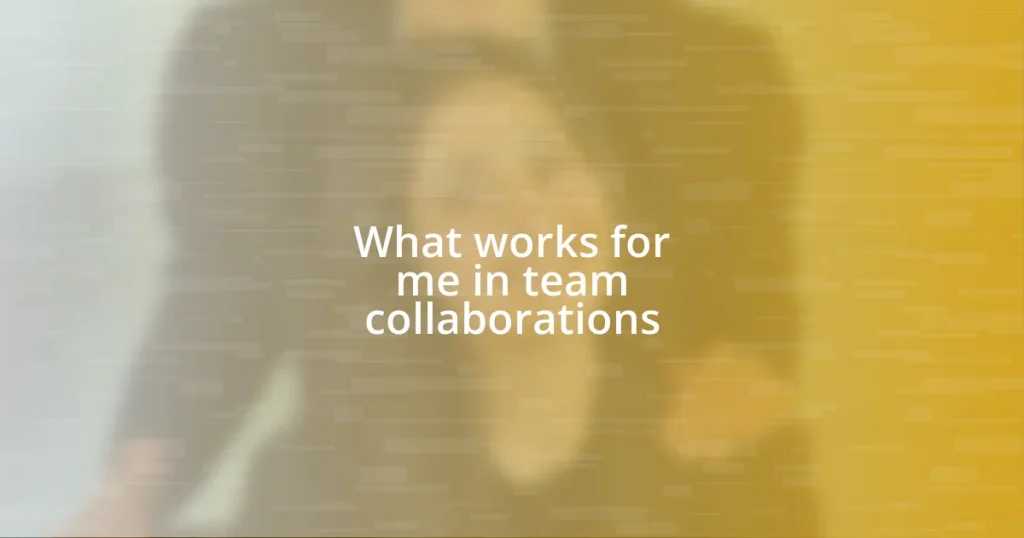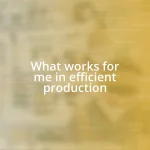Key takeaways:
- Team collaboration enhances project outcomes by pooling diverse skills, fostering camaraderie, and facilitating faster problem-solving.
- Identifying personal collaboration strengths, such as active listening and open communication, empowers individuals and strengthens team dynamics.
- Building trust through openness, follow-through, and celebrating successes creates a productive team environment and encourages continuous improvement.

Understanding team collaboration benefits
Team collaboration brings a wealth of benefits that can truly enhance project outcomes. For instance, when I worked on a marketing campaign, collaborating with my colleagues meant we could pool our diverse skills and viewpoints, resulting in more innovative ideas. Don’t you find it amazing how a simple brainstorming session can lead to breakthroughs that one individual might overlook?
One of the most striking benefits is the sense of camaraderie that develops. I remember a project where we faced tight deadlines and high pressure; that’s when our teamwork really shone. We leaned on each other, supporting one another through challenges, which not only strengthened our final product but also built lasting friendships. Have you experienced that kind of bond with your team?
Moreover, collaboration often leads to faster problem-solving. When we encounter obstacles, having a group to discuss them with opens up multiple perspectives. For example, during a tough deadline, one team member suggested an approach I hadn’t considered, which saved us precious hours. Doesn’t it feel reassuring to know that tackling challenges is a group effort?

Identifying personal collaboration strengths
Recognizing my personal collaboration strengths has been a game changer in my professional journey. One day, while working on a product design team, I discovered that I excel at active listening. By truly focusing on my teammates’ ideas, I was able to synthesize their inputs into cohesive strategies that we could all rally behind. Isn’t it incredible how fostering an environment where everyone feels heard can enhance the collaboration process?
Another strength I’ve identified is my ability to encourage open communication. There was a specific project where one colleague felt hesitant to share his insights about a marketing strategy. I created a safe space during our discussions, where everyone was invited to contribute without fear of judgment. The difference in our project was palpable; it not only sparked new ideas but also created a culture of trust within the team. Have you ever seen a quiet voice become a powerful driver in collaboration simply because someone took the time to listen and encourage?
Finally, I realize that I often play the role of the mediator when conflicts arise. During a particularly heated discussion about direction on a team project, I stepped in to clarify each person’s viewpoint. By doing that, we were able to find common ground and move forward effectively. It’s fascinating how these strengths not only enhance my personal contributions but also uplift the entire team dynamic.
| Collaboration Strength | Description |
|---|---|
| Active Listening | Focusing on teammates’ ideas to synthesize strategies. |
| Encouraging Open Communication | Creating a safe space for all voices to be heard. |
| Mediating Conflicts | Clarifying viewpoints to help find common ground. |

Effective communication techniques in teams
Effective communication is the cornerstone of successful teamwork. I vividly remember a project where we established daily check-ins, which transformed our interactions completely. Initially, misunderstandings were frequent, and messages often got lost between emails. By dedicating just a few minutes each day to share updates, we built a rhythm that kept everyone on the same page and invigorated our collaboration. It’s fascinating how a simple commitment to regular touchpoints can enhance the clarity of communication.
To enhance effective communication in teams, consider these techniques:
- Active Listening: Make a conscious effort to truly hear your teammates. Sometimes, I catch myself nodding along while my mind drifts. Staying present can lead to powerful insights.
- Clarifying Information: Don’t hesitate to ask questions when something isn’t clear. A few weeks ago, a teammate explained a complex process, and by asking clarifying questions, we all left with a much deeper understanding.
- Feedback Loops: Foster an environment where team members can give and receive feedback regularly. I encourage my teammates to share their thoughts openly; it’s amazing how constructive feedback can elevate the entire project.
- Non-verbal Cues: Pay attention to body language during discussions. I’ve noticed that the energy in the room shifts when someone is disengaged, prompting me to draw them in and ensure everyone feels involved.

Strategies for resolving team conflicts
Resolving team conflicts requires a thoughtful and compassionate approach. One time, a disagreement arose when two colleagues had differing visions for a marketing campaign. Rather than letting tensions escalate, I suggested we take a step back. We gathered in a neutral space and each shared our viewpoints without interruptions. It was remarkable to see the frustration dissolve as we realized we both ultimately wanted the same outcome but had different paths to get there. Have you ever noticed how a little space and time can shift perspectives and foster collaboration?
Another effective strategy I’ve found is involving a neutral third party, especially when tempers rise. I vividly recall a situation where emotions were running high over a project’s direction. We brought in a colleague who wasn’t directly involved to mediate the discussion. Their fresh perspective allowed us to break the cycle of negativity. This not only lightened the tension but also accelerated our pathway to a resolution. Isn’t it interesting how a different viewpoint can untangle complex feelings within a team?
Lastly, embracing conflict as an opportunity for growth has transformed my approach to teamwork. Instead of fearing disagreements, I’ve learned to view them as chances to refine ideas. For instance, during a brainstorming session, a critical discussion surfaced about resource allocation. Instead of shutting down, I encouraged everyone to express their concerns openly. The result? We ended up with a more innovative strategy that wouldn’t have been possible had we glossed over our differences. I believe this perspective shift nurtures a more resilient team. Have you ever felt that a conflict led to a stronger outcome than you initially expected?

Building trust within team dynamics
Building trust within a team is an essential ingredient for a productive work environment. In my experience, one of the most effective ways to foster trust is through openness and vulnerability. I remember a time when I shared my struggles with a project deadline during a team meeting. The response was incredible—others opened up about their challenges, creating a safe space where we could be honest about our workloads. Have you ever noticed how sharing personal hurdles can break down walls and encourage collaboration?
Another important aspect of trust is follow-through. When commitments are made, it’s crucial to uphold them. I once worked with a teammate who promised to deliver specific data on time but faced unexpected challenges. Instead of going silent, she communicated her delays, and we all worked together to adjust the workflow. This transparency reinforced my trust in her, as it showed that we were in it together, regardless of setbacks. How do you think consistent accountability impacts trust within a team?
Finally, celebrating successes, no matter how small, plays a pivotal role in strengthening team bonds. I recall a project wrap-up where we took a moment to acknowledge each member’s contributions. It wasn’t just a pat on the back; it was an acknowledgment that each person mattered. This simple act of recognition ignited a sense of camaraderie that kept us motivated for future projects. What if we all made it a point to celebrate the little wins? Emphasizing these moments can build a culture of trust that propels the entire team forward.

Leveraging diverse perspectives for innovation
When I think about leveraging diverse perspectives for innovation, a memorable project comes to mind. During a product design phase, our team was a mix of engineers, marketers, and designers, each bringing unique insights. I watched in awe as combining those different viewpoints led to a breakthrough idea that none of us could have generated alone. Have you ever experienced that exhilarating moment when a fresh idea emerges from a group discussion? It’s that collective synergy that truly pushes boundaries.
One particularly enlightening experience was a brainstorming session where we intentionally included voices from different departments. Their input not only enriched our dialogue but also revealed aspects of the market we hadn’t considered. For instance, the customer support team shared common issues they faced, which sparked innovative solutions in our design. It made me realize how much I had underestimated the value of diverse voices. What if tapping into varied perspectives became our standard practice rather than an exception?
Diversity in perspectives doesn’t just fuel creativity; it fosters an environment where everyone feels valued. I recall how one quieter team member suggested a bold idea during a heated debate, leading to a revolutionary approach. This moment taught me that everyone has something significant to contribute, regardless of their role or temperament. I believe that embracing this principle can transform any team’s innovation process. Isn’t it empowering to think that the next great idea could come from the least expected place?

Continuous improvement in collaboration practices
Continuous improvement in collaboration practices isn’t just a goal—it’s a journey. I remember the time our team implemented weekly check-ins to discuss what was and wasn’t working in our collaboration. It became a platform where everyone felt empowered to share thoughts and suggest tweaks. Over time, those small adjustments transformed our workflow, leading to a noticeable increase in both efficiency and morale. Have you ever implemented a routine that ended up becoming a game-changer?
One key aspect I’ve found invaluable is to cultivate a mindset of experimentation. I once participated in a project where we decided to trial new tools for communication. Initially, it was a bit clumsy, but the willingness to adapt became ingrained in our culture. Each trial brought lessons that allowed us to refine our approach. I genuinely believe that treating each challenge as a learning opportunity fosters resilience within the team. How often do we allow ourselves the grace to learn from missteps in our collaborative efforts?
Reflecting on this, the act of inviting feedback becomes crucial. There was a project where we took a moment to reflect after every milestone, asking ourselves: “What can we do better next time?” This practice wasn’t just about acknowledging shortcomings; it created a safe space for everyone to voice their insights, leading to ideas that truly resonated. I find that when team members feel their opinions are valued, they also feel more invested in the process. Isn’t it fascinating how a simple feedback loop can elevate the entire experience of collaboration?















